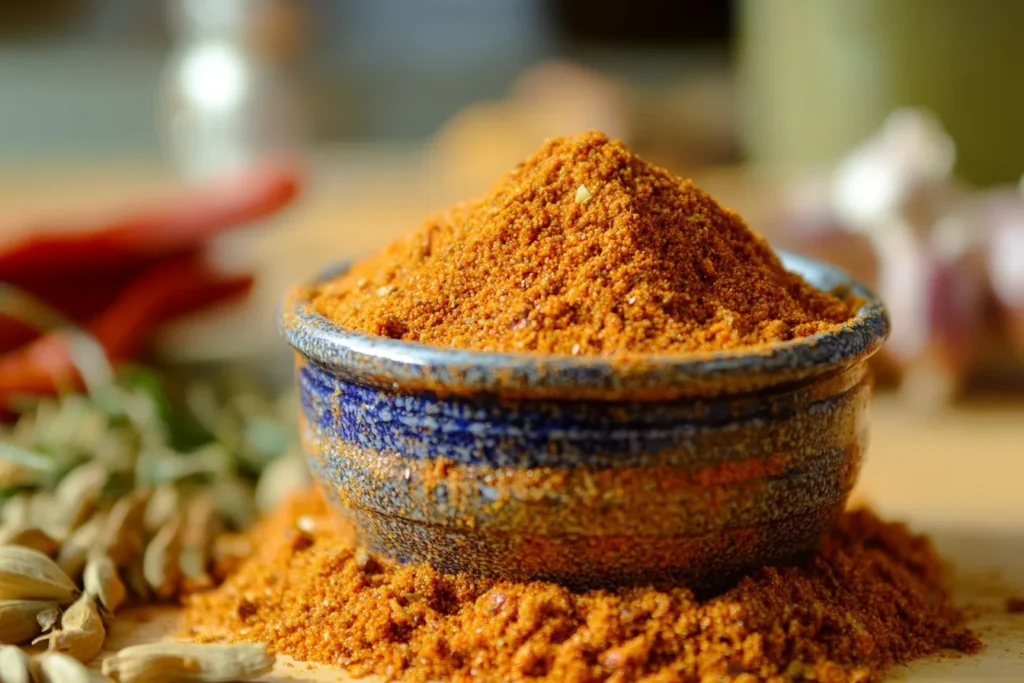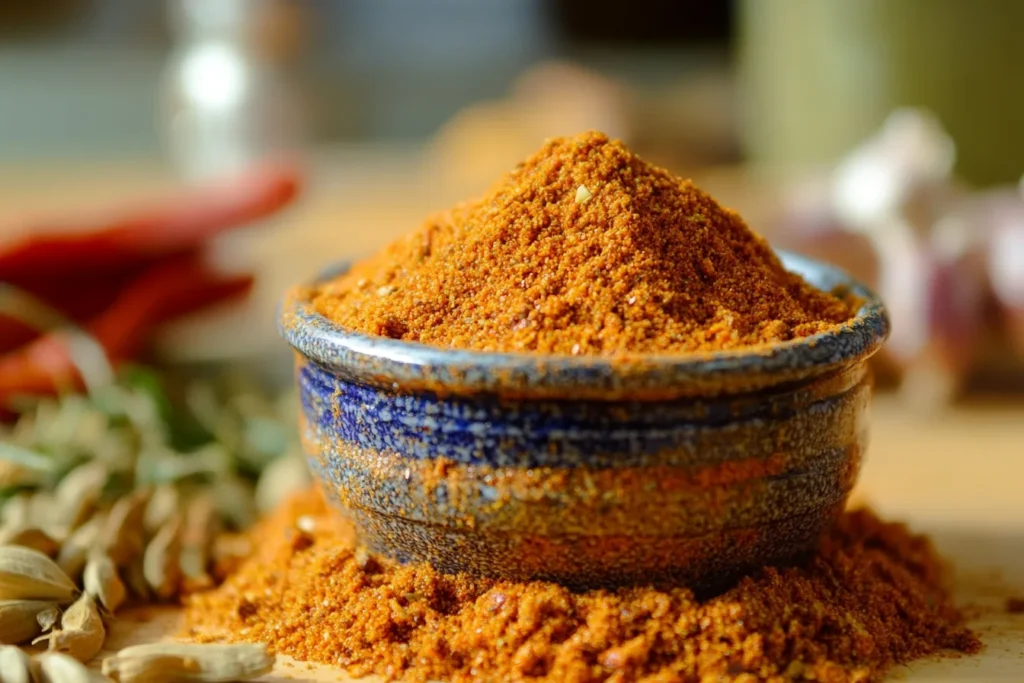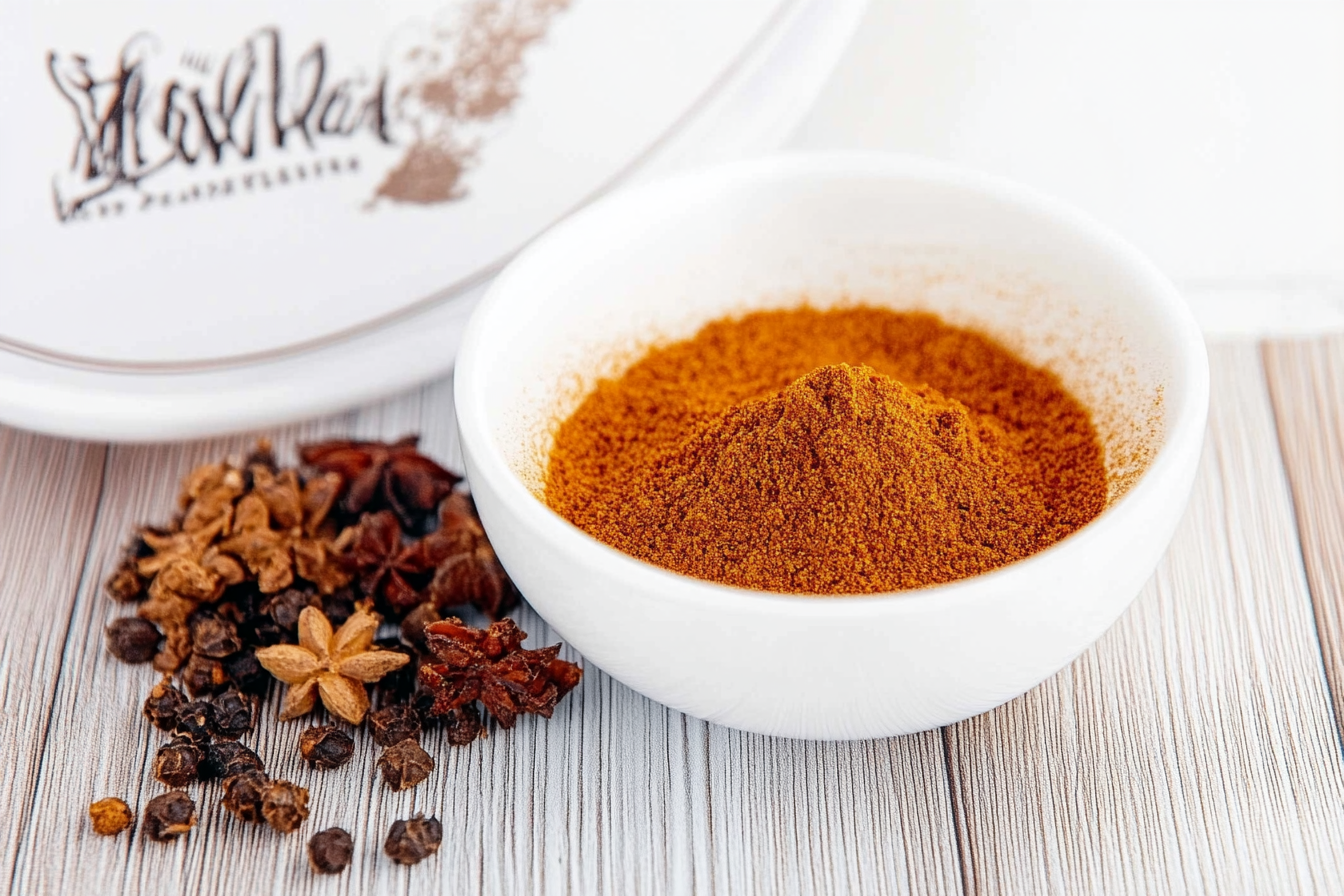Part 1: Introduction and Basics
Introduction to Masala Powder
Masala powder is the heart of Indian cuisine. It’s an aromatic blend of spices that transforms ordinary dishes into culinary masterpieces. With its unique combination of flavors, ranging from earthy and spicy to sweet and pungent, masala powder has made Indian cooking iconic worldwide. For example, whether you are preparing a hearty curry or a simple stir-fry, masala powder plays a vital role in enhancing both the taste and aroma of these dishes.
The term “masala” comes from the Hindi word for spice mix, which underscores its role as a central element in Indian cooking traditions. However, you may wonder, what is masala powder made of? The answer lies in a carefully curated blend of spices, which can vary significantly depending on regional, cultural, and even personal preferences.
Historical Background
The origins of masala powder trace back to ancient India, where spices were not only used for flavor but also for their medicinal properties. In fact, Ayurveda, the traditional system of Indian medicine, often recommended specific spice blends to balance the body’s doshas (energies). Over time, these blends transitioned from medicinal applications to culinary practices, becoming an integral part of Indian kitchens.
Additionally, India’s position as a major hub in the global spice trade further enriched the evolution of masala powders. As Persian, Arab, and European traders introduced new ingredients and techniques, Indian spice blends became even more diverse. Today, the influence of these historical interactions can still be found in the wide variety of masala powders used across India.

What is Masala Powder?
At its core, masala powder is a mix of ground spices tailored to complement specific dishes. Each blend is unique, offering its own flavor profile and intended use. For instance, garam masala delivers warmth and depth, while chaat masala is tangy and zesty. This diversity reflects the richness of Indian culinary traditions.
Key characteristics of masala powder include:
- An intense aroma that elevates dishes.
- A balance of sweet, savory, and spicy notes.
- A fine or coarse texture, depending on the preparation method.
Significance in Cooking
Masala powders are indispensable in Indian cooking. Not only do they flavor the food, but they also act as natural preservatives while enhancing texture and color. For instance, spices like turmeric provide a golden hue, while cumin and coriander add depth to the dish.
Dishes such as curries, biryanis, and dals rely heavily on masala powders for their signature tastes. Furthermore, their versatility makes them a go-to ingredient in fusion dishes, proving their global appeal.
Versatility of Masala Powder
Masala powders are used in a wide array of recipes, showcasing their adaptability across cuisines and dishes. For example:
- Classic Indian dishes: Think of rich curries, hearty lentils, and flavorful kebabs.
- Snacks: Masala powders are perfect for seasoning samosas, pakoras, or even roasted nuts.
- International cuisines: From spicing Moroccan tagines to flavoring Mexican tacos, masala powders have transcended borders.
Types of Masala Powders
There are countless varieties of masala powder, each with its own distinct characteristics. Some of the most popular ones include:
- Garam Masala: A warming blend of spices like cinnamon, cloves, and cardamom.
- Chaat Masala: Known for its tangy and zesty flavor, it’s often sprinkled on salads and street food.
- Sambar Powder: A South Indian staple used for lentil-based stews.
- Tandoori Masala: This blend is perfect for marinades, especially in grilled dishes.
These blends highlight the diversity and creativity in Indian cooking.
Regional Variations
India’s vast geography and cultural diversity have given rise to region-specific masala powders. For instance:
- In Punjab, garam masala is a kitchen staple for hearty curries and dals.
- The South boasts blends like rasam powder and sambar powder, which are integral to their cuisine.
- In Bengal, panch phoron (a five-spice mix) reigns supreme.
These variations demonstrate how the same basic ingredients can create entirely different culinary experiences.
Traditional vs. Commercial Masala Powders
The debate between homemade and store-bought masala powders often boils down to freshness and convenience. Homemade blends are prized for their superior flavor and the personal touch they bring to dishes. In fact, many families pass down their masala recipes through generations, preserving a sense of tradition.
On the other hand, store-bought masalas offer consistency and ease of use, which is especially valuable in modern, fast-paced lifestyles. Both options have their merits, and choosing between them often depends on the cook’s needs and priorities.
Health Benefits
The spices in masala powders are not only flavorful but also loaded with health benefits. For example:
- Turmeric: Renowned for its anti-inflammatory properties.
- Cumin: Known to aid digestion.
- Coriander: Rich in antioxidants that combat oxidative stress.
These therapeutic qualities have contributed to the growing global popularity of Indian spices, which are now embraced for their health-enhancing potential.
Popularity Beyond India
In recent years, masala powder has gained significant traction in international cuisines. For instance, chefs from London to New York have incorporated these spice blends into a variety of dishes, experimenting with their flavors and textures. As a result, masala powders are now a pantry staple in many global kitchens, showcasing their universal appeal.
Part 2: Ingredients and Preparation
Common Ingredients in Masala Powder
The beauty of masala powder lies in its intricate blend of spices. While recipes vary widely, certain core ingredients remain staples. Each spice contributes a distinct characteristic—whether it’s heat, aroma, or color—that collectively defines the masala’s flavor profile.
Here’s a breakdown of the most commonly used ingredients:
- Cumin: Adds earthy warmth.
- Coriander: Offers a citrusy undertone.
- Turmeric: Provides vibrant color and subtle bitterness.
- Red Chili: Delivers heat and spice.
- Black Pepper: Adds sharpness and depth.
These foundational spices are typically complemented by aromatic and regional additions, creating the diversity seen in masala powders.
Core Spices
1. Cumin: Known for its nutty, earthy flavor, cumin is often dry-roasted to release its essential oils, enhancing its impact in the blend.
2. Coriander Seeds: These seeds bring a mild, lemony flavor that balances stronger spices.
3. Turmeric: A crucial ingredient for its vibrant golden color and anti-inflammatory properties.
4. Dried Red Chili: Whether it’s Kashmiri chili for mild heat and bright red hue or spicier varieties, chilies are a must for that characteristic kick.
5. Black Pepper: This versatile spice adds a sharp bite and is often a key ingredient in garam masala.
Aromatic Additions
Aromatic spices elevate masala powder to another level. These spices aren’t just about taste—they add a sensory depth that’s instantly recognizable in Indian cooking.
- Cardamom (Green and Black): Green cardamom offers sweetness, while black cardamom lends smokiness.
- Cloves: Intensely fragrant with a slightly sweet and bitter flavor.
- Cinnamon: Warm, sweet, and woody, this spice often forms the backbone of blends like garam masala.
- Nutmeg and Mace: Used sparingly, these spices impart a subtle sweet and nutty note.
Unique Regional Ingredients
Some masala powders feature spices that are native to or commonly used in specific regions:
- Star Anise: Common in South Indian blends for its licorice-like aroma.
- Fenugreek Seeds: Often found in sambhar and curry powders, lending a slightly bitter flavor.
- Stone Flower (Dagad Phool): A lesser-known spice used in Maharashtra’s Goda masala, adding a smoky depth.
Proportions and Blending
The proportion of spices is critical to achieving a balanced flavor in masala powder. For instance:
- A higher ratio of red chilies creates a spicier blend.
- Increased coriander seeds result in a lighter, more citrusy profile.
The blending process often involves multiple steps:
- Dry Roasting: Toasting the spices to enhance their natural oils and intensify the aroma.
- Grinding: Using a mortar and pestle or a spice grinder to achieve a fine or coarse texture.
- Mixing: Combining ground spices in precise proportions.
Dry vs. Wet Masalas
Not all masalas come in powder form. Dry masalas are blends of ground spices, while wet masalas incorporate fresh ingredients like ginger, garlic, and vinegar to create pastes. Wet masalas are common in coastal cuisines, where they’re used for curries and marinades.
The Art of Roasting
Dry roasting spices is a fundamental step in making masala powders. This process:
- Enhances the flavor by releasing essential oils.
- Creates a richer, more complex aroma.
- Prevents the masala from tasting raw or harsh.
Grinding and Storing
Once roasted, spices are ground into a fine powder. Tips for grinding include:
- Using a high-quality spice grinder for consistency.
- Grinding in small batches to preserve freshness.
To maintain potency, masala powders should be stored in airtight containers away from heat and light. Proper storage can extend their shelf life to 6-12 months.
Modern Adaptations
In today’s fast-paced kitchens, ready-made masala blends have become a popular choice. Brands now offer region-specific blends, such as tandoori masala or pav bhaji masala, making traditional flavors accessible to everyone.
Substitutions for Allergies or Preferences
For those with dietary restrictions or allergies, masala powders can be customized. For instance:
- Replace nutmeg with cinnamon for a nut-free blend.
- Use paprika instead of red chili for a milder option.
These substitutions ensure that everyone can enjoy the rich flavors of Indian cuisine without compromising their health or preferences.

What is Masala Powder Made Of?
Part 3: Uses and Variations
Common Dishes Using Masala Powder
Masala powder is a cornerstone of Indian cooking, and its use spans an impressive variety of dishes. Notably, its versatility allows it to enhance both flavor and aroma across meals. For instance, it plays a vital role in aromatic curries and fragrant rice dishes, turning ordinary recipes into culinary masterpieces.
Classic Dishes Featuring Masala Powder:
- Curries: Masala powders like garam masala or curry powder are essential for creating the base of dishes such as chicken, lamb, or vegetable curries.
- Biryanis and Pulaos: Special blends, like biryani masala, infuse these rice dishes with depth and complexity.
- Lentil Dishes (Dals): Masala powders bring warmth and spice to dals, which are staples in most Indian households.
Additionally, masala powders are indispensable in popular snacks such as samosas, chaats, and pakoras. By adding layers of flavor, these blends elevate simple treats into unforgettable bites.
Everyday Cooking
In everyday Indian meals, masala powders are the go-to seasoning for a wide range of dishes. For example:
- Vegetable Stir-Fries: A pinch of masala powder can transform the simplest vegetable dishes into flavorful delights.
- Soups: Spices like turmeric and black pepper, found in many masala powders, not only add flavor but also contribute medicinal properties.
- Grilled Meats and Vegetables: Tandoori masala is widely used for marinades, creating flavorful and vibrant grilled dishes.
What’s more, masala powders are not confined to Indian cuisine. These spice blends are increasingly used to enhance roasted potatoes, scrambled eggs, or even tomato-based pasta sauces in global kitchens.
Specialty Cuisines
The diversity of regional cuisines in India revolves around the use of unique masala powders. For instance:
- Kerala Fish Curry: This features a tangy and spicy masala blend with ingredients such as tamarind and fenugreek.
- Punjabi Chole: A robust chickpea curry made with a dark, roasted chana masala.
- Goan Vindaloo: A fiery and tangy curry that uses a vinegar-based spice mix for its signature taste.
These regional specialties highlight the depth and richness of Indian cuisine, showcasing how masala powders are crafted to suit specific cultural preferences.
Fusion Recipes
As culinary boundaries blur, masala powders are increasingly finding their place in fusion cooking. For example:
- Masala Burgers: Adding a pinch of garam masala to burger patties infuses them with warm, spicy notes.
- Spiced Popcorn: Tossing popcorn with chaat masala creates a tangy and addictive snack.
- Masala Pasta: Indian spices can be used to flavor tomato-based pasta sauces for a spicy twist.
- Masala Cocktails: Bartenders are experimenting with spice blends in cocktails, resulting in unique drinks like garam masala-infused martinis.
These creative uses underscore how masala powders can seamlessly adapt to modern culinary experiments.
Shelf Life and Storage Tips
To maintain the freshness and potency of masala powders, proper storage is essential. Here’s how you can ensure they last longer:
- Airtight Containers: Prevents moisture and air from degrading the spices.
- Cool, Dark Place: Protects the spices from heat and light, which can weaken their flavor and aroma.
- Small Batches: Grinding spices in smaller quantities ensures you always have fresh masala on hand.
Although most masala powders remain usable for 6-12 months, their potency can fade over time. For the best results, consider replacing them regularly to preserve their vibrancy.
Signs of Spoilage
Even with careful storage, masala powders can lose their flavor or spoil. Watch for these warning signs:
- Dull Aroma: This indicates the spices have gone stale.
- Clumping: Suggests exposure to moisture.
- Off Taste: A rancid or unpleasant taste signals that the masala is no longer usable.
To ensure your dishes remain flavorful and safe, it’s important to discard old or spoiled masala powders.
Homemade vs. Store-Bought Recipes
The choice between homemade and store-bought masala powders depends on personal preference, convenience, and flavor priorities.
Homemade Masala:
- Pros: Fresher, customizable, and free of preservatives.
- Cons: Time-consuming to make and requires a wide variety of spices.
Store-Bought Masala:
- Pros: Convenient, consistent, and widely available.
- Cons: May contain additives or lack the complexity of homemade blends.
Each option has its advantages, and the best choice depends on your cooking style and time constraints.
How to Choose the Right Masala
Selecting the perfect masala powder depends largely on the dish you’re preparing. To make the right choice:
- Read Labels: Opt for blends with minimal additives or artificial preservatives.
- Consider the Cuisine: Region-specific masalas, such as tandoori masala or chana masala, deliver authentic flavors for specific dishes.
- Test Freshness: Fresher masalas will have a strong, inviting aroma and vibrant color.
Investing in high-quality masala powders can significantly enhance the taste of your meals.
Tips for Customization
One of the most rewarding aspects of using masala powders is their flexibility. You can easily customize blends to match your personal taste preferences:
- Reduce Heat: For a milder blend, use Kashmiri chili instead of spicier varieties.
- Enhance Aroma: Adding more cardamom or cinnamon brings a sweeter, more fragrant profile.
- Experiment: Consider incorporating unusual ingredients like dried rose petals or saffron to create a signature spice blend.
These tweaks make masala powders truly your own, tailored to your unique culinary style.
Final Thoughts and Recommendations
Masala powders are more than just a collection of spices—they are a testament to the depth and creativity of Indian cuisine. By exploring different types, dishes, and adaptations, you can introduce bold flavors into your kitchen while honoring centuries of culinary tradition. Whether you stick to classic recipes or venture into fusion creations, masala powders are a versatile ingredient that can transform your cooking.
More FAQs
- Can I use masala powder in non-Indian dishes?
Absolutely! They work well in soups, grilled meats, and even pasta sauces. - How do I store masala powder to maintain freshness?
Use airtight containers and store in a cool, dark place. - What’s the difference between garam masala and curry powder?
Garam masala is used for finishing dishes, while curry powder is a base blend containing turmeric. - Can I make masala powder without a grinder?
Yes, a mortar and pestle works well, though it requires more effort. - Is it better to buy whole spices or pre-ground ones?
Whole spices are better as they retain flavor longer and can be ground fresh. - Are masala powders healthy?
Yes, they contain spices with anti-inflammatory and antioxidant properties. - How long does homemade masala powder last?
Typically, up to six months if stored properly. - What’s the best masala for beginners?
Garam masala—it’s versatile and widely used. - Are there masala powders for desserts?
Yes, blends like chai masala are perfect for sweet dishes and teas. - Can I use masala powder as a rub for meats?
Absolutely! Tandoori masala and similar blends are excellent for marinades.
Related Article : chicken masala powder recipe

